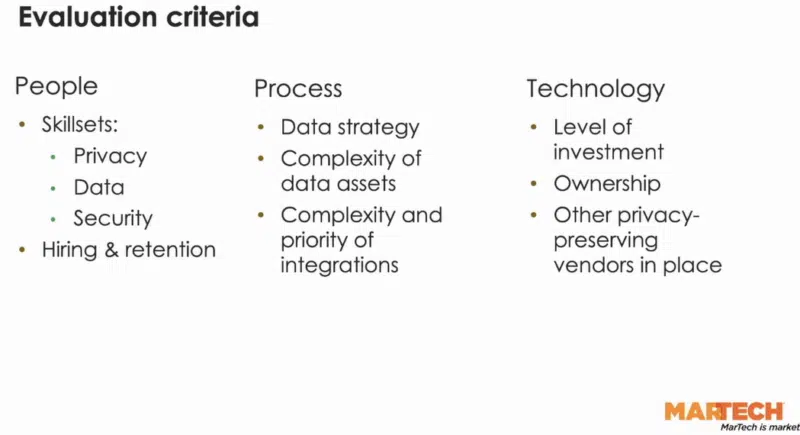Evaluating data clean rooms for your organization
What data clean room is right for you? It depends on the team and technology you have in place.
Data clean rooms (DCRs) are an emerging technology that enables marketers to combine data sets with those from other parties to reach customers more effectively in a privacy-compliant way. As the technology evolves, marketers are using DCRs in an increasing number of use cases. Here are some of the considerations an organization takes when evaluating if they should use a DCR.
3 types of DCRs
What kind of DCR might your organization pick from the current field? There are three main types of DCR providers, according to Ana Milicevic, principal and co-founder of management consultancy Sparrow Advisers, who spoke recently at The MarTech Conference.
- Walled gardens: Big Tech companies with massive audiences and ad networks (Google, Meta, Amazon).
- Infrastructure providers: Cloud computing services and cloud-based data service providers like Snowflake and AWS.
Dig deeper: Amazon announces AWS Clean Rooms
DCRs as a product or feature
With the wide range of options available, organizations can choose between purchasing DCR technology as a stand-alone product, or as a feature built off of a broader data services offering.
“It’ll depend,” said Milicevic. “Some [marketers], depending on the entirety of your marketing operations, will need them as a product. Some of you will need them as a feature — and knowing which one is where it gets tricky.”
Evaluating your organization for DCR readiness
Milicevic recommends a three-pronged approach for evaluating your organization’s DCR needs.

Much of the success of a DCR depends on the people your organization has in place.
“[Organizations using] clean rooms really have to take into account the people — the skill sets are fairly advanced,” said Milicevic. “You’ll have to have a team with experience in privacy, data and security. And you’ll have to have the ability to hire and retain them.”
About half of the companies using a DCR employ between six and 10 people tasked with privacy-related technology, Milicevic said.
The organization will also have to be sure it’s mature enough to handle complex data assets shared through a DCR.
“Do you understand the complexity and priority of various integrations, for example with [data] enrichment partners or with activation partners on the other end?” Milicevic asked.
Once you have a grasp of the people and data maturity within your organization, it’s easier to narrow down the list of DCR vendors to match your needs and budget.
Register and watch The MarTech Conference here.
Related stories